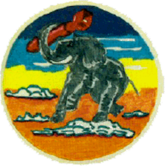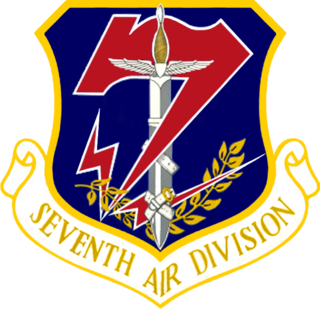
The 7th Air Division served the United States Air Force with distinction from early 1944 through early 1992, earning an outstanding unit decoration and a service streamer along the way.

The 499th Air Refueling Wing is an inactive United States Air Force (USAF) unit that was last active at Westover AFB, Massachusetts in June 1966.

The 416th Air Expeditionary Wing (AEW) is a provisional unit assigned to the Air Combat Command of the United States Air Force to activate or inactivate as needed.
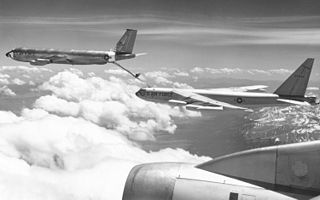
The 462d Air Expeditionary Group is a provisional unit of the United States Air Force. It is assigned to Air Mobility Command to activate or inactivate as needed to meet operational requirements. Its last assignment was at Naval Support Facility Diego Garcia, British Indian Ocean Territory.

The 465th Bombardment Wing is an inactive United States Air Force unit. It was last assigned to the 57th Air Division of Strategic Air Command at Robins Air Force Base, Georgia, where it was inactivated on 21 July 1968.

The 70th Air Refueling Squadron is an Air Force Reserve Command unit, assigned to the 349th Operations Group at Travis Air Force Base, California. It is an associate of the active duty 9th Air Refueling Squadron, United States Air Force, and operates the McDonnell Douglas KC-10 Extender aircraft conducting mobility, and air refueling missions. The squadron has served in this role since 1994.

The 820th Strategic Aerospace Division is an inactive United States Air Force organization. Its last assignment was with Strategic Air Command (SAC)'s Eighth Air Force at Plattsburgh Air Force Base, New York, where it was inactivated on 25 June 1965.

The 99th Air Refueling Squadron is part of the 6th Air Mobility Wing at MacDill Air Force Base, Florida, but is stationed at Birmingham Air National Guard Base, Alabama. It is an Active Associate Unit, an active duty component attached to the Alabama Air National Guard's 117th Air Refueling Wing. The 99th Air Refueling Squadron works with, supports and flies the 117th Air Refueling Wing's Boeing KC-135R Stratotanker aircraft.
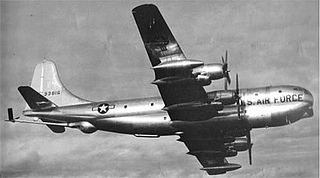
The 40th Air Refueling Squadron is an inactive United States Air Force unit. It was last assigned to the 310th Strategic Aerospace Wing at Schilling Air Force Base, Kansas, where it was inactivated on 15 March 1963. The squadron's first predecessor is the 540th Bombardment Squadron, which served as a heavy bomber training unit during World War II until inactivating in a 1944 reorganization of Army Air Forces training units. The 40th Squadron was activated at Schilling in 1952 and performed worldwide refueling missions until inactivated.

The 509th Weapons Squadron is a United States Air Force unit. It is assigned to the USAF Weapons School at Fairchild Air Force Base, Washington. The squadron is a geographically separated unit of the 57th Wing at Nellis Air Force Base, Nevada.

The 68th Air Refueling Squadron is an inactive United States Air Force unit. It was last assigned to the 305th Bombardment Wing at Bunker Hill Air Force Base, Indiana, where it was inactivated on 25 March 1965.

The 75th Bombardment Squadron is an inactive United States Air Force unit. It was first established as a bombardment squadron shortly before World War II. It was reactivated during the Cold War as a Strategic Air Command (SAC). Its last assignment was to the 4039th Strategic Wing at Griffiss Air Force Base, New York, where it was made inactive on 1 February 1963.
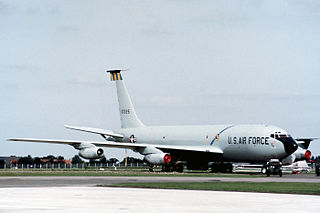
The 407th Air Refueling Squadron is an inactive United States Air Force unit. It was last assigned to the 42nd Bombardment Wing at Loring Air Force Base, Maine, where it was inactivated on 1 October 1990.

The 920th Air Refueling Squadron is an inactive United States Air Force unit. It was last assigned to the 379th Bombardment Wing at Wurtsmith Air Force Base, Michigan where it was inactivated on 30 September 1992.

The 668th Bomb Squadron is an inactive United States Air Force unit. It was last assigned to the 416th Operations Group at Griffiss Air Force Base, New York, where it was inactivated on 1 January 1995.

The 421st Air Refueling Squadron is an inactive United States Air Force unit. It was last assigned to the 41st Air Division at Yokota Air Base, Japan, where it was inactivated on 18 February 1965.
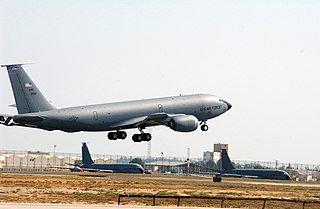
The 900th Expeditionary Air Refueling Squadron is a provisional United States Air Force unit. It was last known to be assigned to the 398th Air Expeditionary Group at Incirlik Air Base, Turkey.

The 902d Expeditionary Air Refueling Squadron is an inactive United States Air Force unit. It was last assigned to the 70th Bombardment Wing at Clinton-Sherman Air Force Base, Oklahoma, where it was inactivated on 31 December 1969.
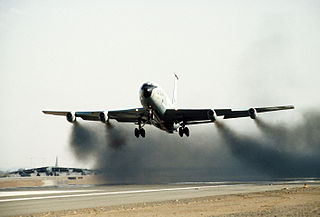
The 916th Air Refueling Squadron is an inactive United States Air Force unit. It was last assigned to the 307th Air Refueling Group at Travis Air Force Base, California, where it was inactivated on 31 October 1983.

The 919th Air Refueling Squadron is an inactive United States Air Force unit. It was last assigned to the 306th Bombardment Wing, stationed at McCoy Air Force Base, Florida. It was inactivated on 30 June 1971.


